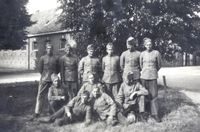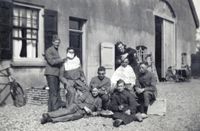Hotze Jelle Kleefstra 2-I-17RA.
Below you will find the photos of Conscript Soldier Hotze Jelle Kleefstra. The photos were donated to Dordrecht during the war by his son.
Hotze Jelle Kleefstra, a hairdresser by profession, was born in Aldeboarn, Utergadeel in the province of Friesland on April 27, 1918. Like many others of his age, he was conscripted as an ordinary draftee (GD). In his case, this happened on February 20, 1939, as part of the 1938 draft class in the 4th Field Artillery Regiment. His role and stationed location were Gunner (unmounted) at 4 RVA in Ede. After completing his training as a gunner, he was transferred to 2-I-17RA (2nd Battery - 1st Department - 17th Regiment Artillery) on August 25, 1939.
The photos below were taken at the Van Essen Barracks in Ede, where Hotze Jelle was initially stationed with 4 RVA. *1
Together with his unit, he was then stationed in Dubbeldam. The 1st department of the 17th Artillery Regiment (I-17RA) had 8 pieces of 7-veld artillery at their disposal, with four pieces per battery, relatively modern gun for that time. The artillery positions were located in the Beerpolder between Tweede Tol and Willemsdorp, and were intended to provide fire support for the Moerdijk bridgehead. The locations where the I-17 RA personnel were accommodated were further back. Among them were the barracks camp near Tweede Tol and several farms along the Wieldrechtse Zeedijk. Not far from there, the battery office was located in the school on the (rijk) Straatweg. However, most of the personnel were dispersed among various farms in the vicinity of the Wieldrechtse Zeedijk.
Likewise, Hotze Jelle was likely stationed at Killesigt Farm. Some of the photos are indeed a capture of Killesigt Farm, and one of the photos is annotated as the farm where Hotze Jelle was stationed. Killesigt Farm was located, as the name suggests, on the Kiloever in the extension of the Wieldrechtse Zeedijk (approximately in the southwest corner of the current Dordtse Kil III area).
VFor Hotze Jelle, the war began as a bolt out of the blue. He was likely awakened, just like the soldiers at Willemsdorp, by the Luftwaffe bombardment on the Moerdijk bridgehead and the cover detachment at Willemsdorp. Shortly after, the first German paratroopers jumped out of their planes. As a result, the personnel of I-17RA found themselves right in between the landing zones of the 1st and 2nd battalions of Fallschirmjäger Regiment 1. At the barracks camp near Tweede Tol, fierce fighting quickly broke out between the I-17RA artillerymen and the German paratroopers. *2
Below you can find a fragment from the combat report of the battery commander of 2-I-17 RA: Captain J.W. Baretta *3.
Captain Baretta had taken position in the headquarters, along with artillerymen from 1-I-17 RA and 2-I-17 RA, at the school on the (Rijks)Straatweg. There, they encountered German paratroopers. Captain Baretta and his units from I-17 RA were eventually forced to surrender after running out of ammunition to return fire. During the surrender, 23 men from I-17 RA were taken as prisoners of war, including presumably Hotze Jelle Kleefstra. The troops who managed to escape fled to either Kiloever or Gravesteijn. *4
The artillery pieces of I-17 RA fell into German hands undamaged and were later even put to use by German paratroopers.
Above you can see the photos from Hotze Jelle's mobilization period. In the first photo, you can see Hoeve Killesigt, as explained, it was located at the southwestern point of the current Dordtse Kil III. The farmhouse no longer exists. It was likely his quarters during his mobilization in Dubbeldam and Wieldrecht. There are several group photos, presumably of comrades from the 2nd battery, 1st department, 17th Regiment Artillery. If you zoom in on photo 5, you can clearly see the artillery collar insignia, particularly on Hotze Jelle. In October 1995, Hotze Jelle was awarded the Mobilization War Cross. His son wrote me a letter, which he included with the photos, saying: "Unfortunately, I have little information because my father never wanted to speak about it. The little he did disclose was that it was a horror."
We will never know exactly what Hotze Jelle experienced in May 1940, but with some research, the story has now become more complete.
Of the 2nd battery, 1st department, 17th Regiment Artillery, four men were killed in action:
Sergeant J.J.L. van Geel.
Conscript soldier A.H. Groothuis.
Conscript soldier H. Loomulder.
Conscript soldier B. Mulder.
Ten more soldiers from the other units of I-17 RA were killed in May 1940. They may appear in one of the photos, and perhaps they were comrades of Hotze Jelle. *5
I am very curious if there are any other individuals who recognize the other soldiers in the photos. If you happen to know, you can email them to: info@dordrechtindeoorlog.nl
©2017-2025 :Https://www.Dordrechtindeoorlog.nl: ( There is a copyright on the content of this website. This content is not to be shared, duplicated or published withouth the explicit permission of the author of this website. If you have any requests you can email to: Info@Dordrechtindeoorlog.nl or look on : www.dordrechtindeoorlog.nl/termsofuseforthecontentonthiswebsite.
*1 Source: Mr. Gerard Gijsbertsen informed me that the first three photo's were made on the van Essenkazerne in Ede.
*2 Source: Zuidfront-Holland1940-Wieldrecht 1e fase.
*3 Source: Archieven.nl - 409 gevechtsverslagen - Pak K XII Zuidfront Vesting Holland - Groep Kil - Artillerie in de groep Kil - Verslag Kapitein Baretta.
*4 Source: Zuidfront-Holland1940-Wieldrecht 2e fase.
*5 Source: Zuidfront-Holland1940-Nederlandse gesneuvelden.







